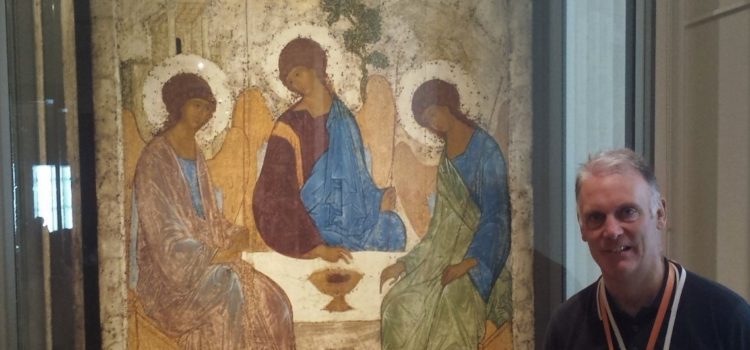
I have recently returned from a week’s holiday in Russia. My trip began with Sunday morning worship at St Andrew’s Anglican Church in Moscow. There was an 11am Family Service for Harvest Thanksgiving, which was exactly the service I was missing back in Lapworth! Because Moscow is two hours ahead of the UK, I was able to send greeting to people in Lapworth after the Moscow service, and before the Lapworth service started.
After a very Anglican start, much of the rest of my trip was about getting to know and better understand the Russian Orthodox Church. I visited many Russian Orthodox Church buildings. They typically have domes, often onion shaped, and are highly decorated on the inside with murals and icons.
The icons are very important. They are typically pictures of Jesus, Mary, angels or saints, although they can also depict biblical scenes associated with the festivals of the Orthodox church. The icons are usually painted on wood in accordance with a set of traditional rules to make them suitable for veneration in church. An icon is meant to help a worshipper to build their relationship with the saint or event depicted. They seek to be the visual equivalent of the words of the gospel. It was interesting to watch people in church crossing themselves, bowing to an icon, approaching it, often kissing it and resting in pray for a few moments before it, and then reversing the procedure and moving away, often to another icon.
I attended a brief moment of Russian Orthodox liturgy. There were icons, murals and very grand clergy robes to look at. There was top quality singing to listen to. The smell of incense was all pervading. All the senses were engaged and everything seemed designed to give an experience of heaven.
Russian Orthodoxy seems so closely tied up with Russian nationalism. For example, important Russian military leaders have attributed their successes in repelling invading armies to prayers made through the icon Our Lady of Kazan.
The Church of England is often described as a “Broad Church” because different traditions, catholic, evangelical and reformed all manage to coexist within it. Orthodoxy is another tradition again. I find I have to adopt an attitude of dialogue, seeking to understand and appreciate what is good in the other without feeling threatened by the differences.
With prayers and best wishes, Fr Patrick
Prayer Adapted from Angela Ashwin
Thank you, Father, for different places of prayer,
for the faith that has blossomed within them,
for the worship offered, and the lives transformed.
Bless all who come to worship.
May they know the whisper of your love,
for you are a God of renewal and steadfastness,
now and forever. Amen.

